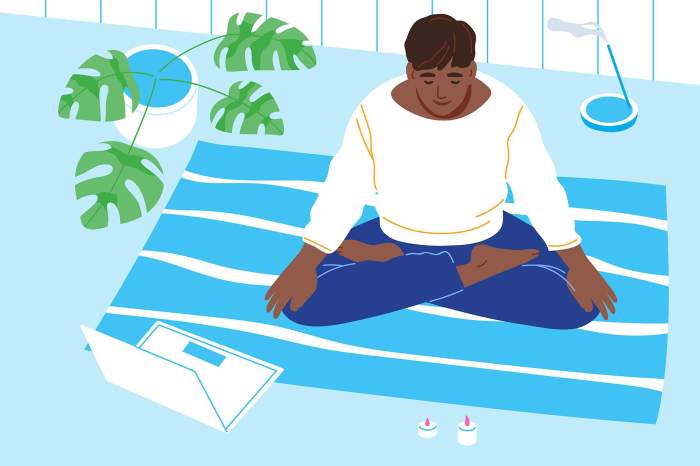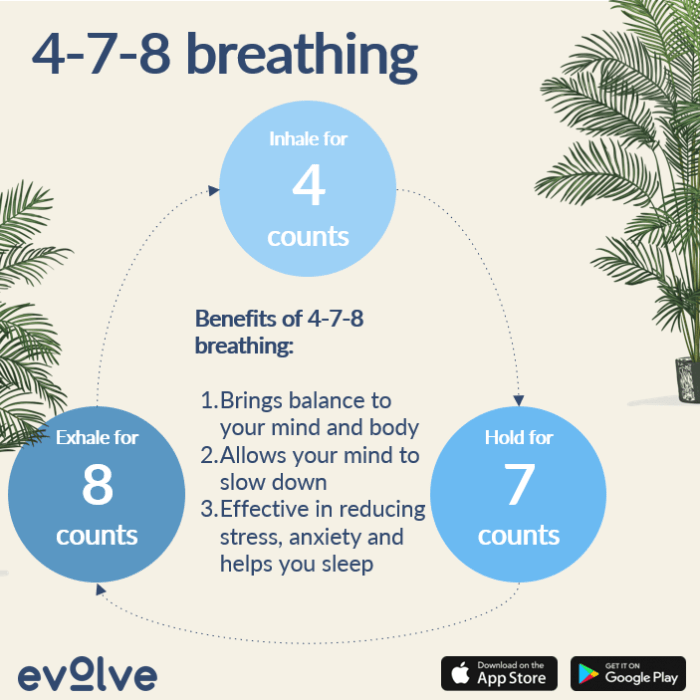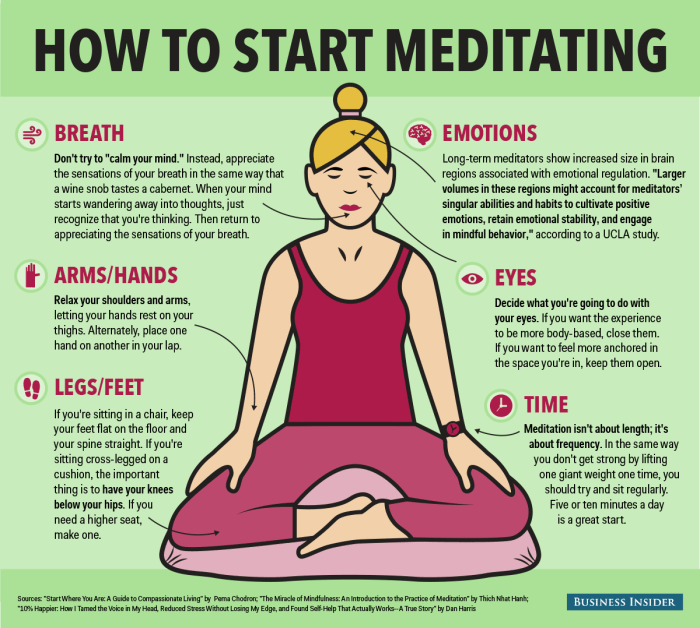With 7 Meditation Techniques to Overcome Anxiety at the forefront, embark on a journey towards tranquility and calmness. Dive into the realm of mindfulness and serenity as we explore powerful methods to combat anxiety and restore balance within.
Discover the transformative power of meditation as we delve into various techniques designed to alleviate anxiety and promote mental well-being.
Introduction to Meditation Techniques to Overcome Anxiety

Anxiety is a common mental health condition characterized by feelings of worry, fear, and unease. It can have a significant impact on daily life, affecting relationships, work performance, and overall well-being. Managing anxiety is crucial for maintaining mental health and overall quality of life.Meditation has been recognized as an effective tool for managing anxiety. By incorporating mindfulness practices and deep breathing techniques, meditation helps individuals calm their minds, reduce stress levels, and increase self-awareness.
Regular practice of meditation can lead to improved focus, emotional stability, and a sense of inner peace.
Benefits of Using Meditation to Manage Anxiety
- Reduces stress and promotes relaxation
- Increases self-awareness and emotional regulation
- Improves focus and concentration
- Enhances overall mental well-being
Importance of Regular Meditation Practice
Meditation is a skill that requires consistent practice to experience its full benefits. Just like physical exercise, regular meditation helps individuals build mental resilience and cope with anxiety more effectively. By incorporating meditation into daily routines, individuals can establish a sense of calm and balance in their lives.
Mindfulness Meditation

Mindfulness meditation is a practice that involves focusing on the present moment while acknowledging and accepting one’s thoughts, feelings, and bodily sensations without judgment. This technique has been shown to be effective in reducing anxiety by promoting relaxation, self-awareness, and emotional regulation.
Body Scan Technique
The body scan technique is a mindfulness practice that involves systematically focusing on each part of the body, starting from the toes and moving up to the head. By paying attention to the physical sensations in each part of the body, individuals can become more aware of tension and stress, allowing them to release and relax those areas.
Focused Breathing
Focused breathing is another mindfulness technique where individuals concentrate on their breath, observing the inhalation and exhalation without trying to control or change it. This practice helps to anchor the mind in the present moment, calming racing thoughts and reducing anxiety.
Real-Life Examples
Many individuals have found relief from anxiety through mindfulness meditation. For example, Sarah, a busy professional, used mindfulness techniques to manage work-related stress and improve her focus. By incorporating short mindfulness sessions into her daily routine, she noticed a significant decrease in her anxiety levels and an overall sense of calmness and clarity.
Guided Imagery Meditation
Guided imagery meditation involves visualizing peaceful and calming mental images to reduce anxiety and promote relaxation. By creating a positive mental image, you can shift your focus away from worries and stress, allowing your mind to find a sense of peace.
Creating a Peaceful Mental Image, 7 Meditation Techniques to Overcome Anxiety
- Find a quiet and comfortable space where you can relax without distractions.
- Close your eyes and take deep, slow breaths to center yourself and calm your mind.
- Imagine a place that brings you joy and tranquility, such as a serene beach, peaceful forest, or cozy room.
- Visualize the details of this place – the sights, sounds, smells, and textures. Engage all your senses to make the image vivid and real.
- Stay in this mental image for a few minutes, allowing yourself to fully immerse in the peaceful experience.
Science Behind Guided Imagery Meditation
Guided imagery meditation works by activating the same neural pathways in the brain that are involved in experiencing real-life situations. When you visualize positive scenarios, your brain releases feel-good neurotransmitters like dopamine and serotonin, which can counteract the stress hormones that contribute to anxiety. This practice can help rewire your brain to focus on positive thoughts and emotions, reducing anxiety over time.
Progressive Muscle Relaxation: 7 Meditation Techniques To Overcome Anxiety

Progressive Muscle Relaxation is a technique that involves systematically tensing and relaxing different muscle groups in the body to help release physical tension and promote relaxation. This method has been found to be highly effective in relieving anxiety and stress by helping individuals become more aware of their body’s response to stress and learn how to release that tension.
Process of Progressive Muscle Relaxation
- Find a quiet and comfortable place to sit or lie down.
- Starting with your toes, tense the muscles in each body part for about 5-10 seconds.
- Then, release the tension and focus on the sensation of relaxation for 15-20 seconds.
- Move systematically through each muscle group in your body, working your way up to your head.
Benefits of Progressive Muscle Relaxation
- This technique helps in increasing body awareness and promoting relaxation.
- It can reduce muscle tension and physical symptoms of anxiety, such as tightness in the chest or stomach.
- Progressive Muscle Relaxation can also improve sleep quality and overall sense of well-being.
Loving-Kindness Meditation

Loving-Kindness Meditation, also known as Metta meditation, is a practice focused on cultivating compassion and love towards oneself and others. This technique involves sending well-wishes and positive intentions to oneself, loved ones, acquaintances, and even those with whom we may have difficulties.
How to Practice Loving-Kindness Meditation
- Find a comfortable and quiet place to sit or lie down.
- Close your eyes and take a few deep breaths to center yourself.
- Start by directing loving-kindness towards yourself, repeating phrases like “May I be happy, may I be healthy, may I be at peace.”
- Gradually expand your focus to include loved ones, acquaintances, and even those you may have conflicts with, wishing them well-being and happiness.
- Continue to repeat these phrases and visualize sending love and compassion to each person.
- Practice this meditation for a few minutes each day, gradually increasing the duration as you become more comfortable.
Connection Between Self-Compassion and Anxiety Reduction
Loving-Kindness Meditation has been found to be effective in enhancing self-compassion, which plays a crucial role in reducing anxiety levels. By cultivating feelings of compassion towards oneself and others, individuals can develop a sense of inner peace and acceptance. This practice can help break the cycle of negative self-talk and self-criticism, promoting emotional well-being and resilience in the face of anxiety-inducing situations.
Breathing Exercises

Proper breathing is essential in managing anxiety as it helps regulate the body’s stress response and promotes relaxation. By incorporating different breathing exercises into your daily routine, you can effectively calm your mind and body during anxious moments.
Diaphragmatic Breathing
- Also known as deep breathing, diaphragmatic breathing involves focusing on breathing deeply into the abdomen rather than shallowly into the chest.
- To practice diaphragmatic breathing, sit or lie down in a comfortable position, place one hand on your chest and the other on your abdomen, inhale deeply through your nose, filling your abdomen with air, and exhale slowly through your mouth.
Box Breathing
- Box breathing is a simple technique that involves inhaling, holding your breath, exhaling, and holding your breath again in equal counts.
- To practice box breathing, inhale deeply for a count of four, hold your breath for a count of four, exhale slowly for a count of four, and hold your breath for a count of four before repeating the cycle.
Focused Breathing Techniques
- By focusing on your breath and using techniques such as counting breaths or following a specific pattern, you can redirect your attention away from anxious thoughts and promote a sense of calm.
- Practice focused breathing techniques whenever you feel overwhelmed or anxious to help center yourself and regain control of your thoughts and emotions.
Transcendental Meditation
Transcendental Meditation (TM) is a technique that involves silently repeating a mantra to achieve a state of relaxed awareness. It aims to promote relaxation, reduce stress, and enhance mental clarity.
Role of Mantras in Transcendental Meditation
In TM, practitioners are given a specific mantra to repeat silently during meditation. The use of mantras helps to focus the mind and create a sense of calmness. By chanting these sounds, the mind can transcend conscious thought and access a deeper level of awareness, promoting relaxation and clarity.
Benefits of Transcendental Meditation in Anxiety Management
Many individuals have reported significant benefits from practicing TM in managing anxiety. Research studies have shown that TM can reduce symptoms of anxiety and improve overall mental well-being. Personal experiences and case studies have also indicated that regular practice of TM can lead to decreased stress levels, increased feelings of inner peace, and improved emotional resilience.
Last Point
In conclusion, embracing these 7 Meditation Techniques to Overcome Anxiety can lead to a profound shift in your mental state, fostering resilience and peace amidst life’s challenges. Begin your practice today and witness the transformative effects on your mind, body, and spirit.